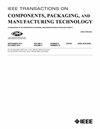Deep Kernel-Based Hyperparameter Adaptive Learning and Frequency Response Predictions Using Transposed Convolutional Neural Network
IF 3
3区 工程技术
Q2 ENGINEERING, ELECTRICAL & ELECTRONIC
IEEE Transactions on Components, Packaging and Manufacturing Technology
Pub Date : 2025-06-12
DOI:10.1109/TCPMT.2025.3578968
引用次数: 0
Abstract
Electronic design automation (EDA) has unique challenges for addressing the design of systems for emerging applications due to the complexities involved, where multiple chiplets are integrated together on a heterogeneous platform. This challenge arises due to the long computation time required for simulation to capture all the necessary first order, second order, and sometimes third-order parasitic effects. Emerging machine learning (ML) and Gaussian process (GP) methods have helped expedite these processes. The deep kernel learning (DKL) model combines the structural properties of deep learning architectures with the nonparametric flexibility of kernel methods. It shows advantages by applying a GP with the corresponding kernel function to the final hidden layer of a deep neural network (DNN). However, DKL sometimes suffers from overfitting and scalability issues. In this article, we propose an adaptive learning framework for基于深度核的超参数自适应学习和基于转置卷积神经网络的频率响应预测
由于涉及的复杂性,电子设计自动化(EDA)在解决新兴应用系统设计方面面临着独特的挑战,其中多个芯片集成在异构平台上。这一挑战的出现是由于模拟捕获所有必要的一阶、二阶和有时是三阶寄生效应所需的长计算时间。新兴的机器学习(ML)和高斯过程(GP)方法有助于加快这些过程。深度核学习(DKL)模型将深度学习体系结构的结构特性与核方法的非参数灵活性相结合。将具有相应核函数的GP应用于深度神经网络(DNN)的最终隐藏层,显示出其优势。然而,DKL有时会遇到过拟合和可伸缩性问题。在本文中,我们提出了一个自适应学习框架,用于s参数预测,结合频谱转置卷积神经网络(S-TCNN)和DKL。该模型从设计空间中获取输入参数,通过转置卷积层对其进行上采样,并利用GP核层来近似期望的核函数。此外,潜在特征空间自适应地从输入矩阵中压缩和提取特征,作为GP核层的单独输入参数。进一步,我们讨论了训练策略和模型的可扩展性。采用两个先进的包装实例对所提出的模型进行了测试和评价。结果表明,超参数数量减少了50%以上,损耗和归一化均方误差(NMSE)改善了约40%。
本文章由计算机程序翻译,如有差异,请以英文原文为准。
求助全文
约1分钟内获得全文
求助全文
来源期刊

IEEE Transactions on Components, Packaging and Manufacturing Technology
ENGINEERING, MANUFACTURING-ENGINEERING, ELECTRICAL & ELECTRONIC
CiteScore
4.70
自引率
13.60%
发文量
203
审稿时长
3 months
期刊介绍:
IEEE Transactions on Components, Packaging, and Manufacturing Technology publishes research and application articles on modeling, design, building blocks, technical infrastructure, and analysis underpinning electronic, photonic and MEMS packaging, in addition to new developments in passive components, electrical contacts and connectors, thermal management, and device reliability; as well as the manufacture of electronics parts and assemblies, with broad coverage of design, factory modeling, assembly methods, quality, product robustness, and design-for-environment.
 求助内容:
求助内容: 应助结果提醒方式:
应助结果提醒方式:


